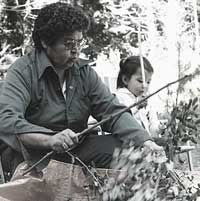
|
Seasonal Round: It is important to note that Secwepemc people today continue to gather resources from within their traditional territories. They apply the same basic knowledge and skills that were used in pre-contact times. As a culture dependent on the food that the land provides, the Secwepemc are highly attuned to their surroundings. Much attention is given to seasonal changes and weather patterns. It is also important to have specialized skills and knowledge about the plant and animal world. The seasonal rounds of the Secwepemc are guided by the land's ever changing cycle. |
An Introduction:
In spring, summer and fall the Secwepemc would travel to different resource areas. However, during the harsh winters they would settle in winter villages. Each locale had different environmental rhythms. In areas where resources were particularly scarce, the people would move to other sites more frequently. Consequently, areas with great abundance and variety would be settled at for longer periods of time.
Secwepemc people today continue to follow the seasonal rounds and gather resources from within their traditional territories.
In essence, the Secwepemc travelled to their food resources. Many resources were available for harvest at certain times of the year and in specific areas. The Secwepemc would plan their seasonal rounds to correspond with the availability of resources.
 |
| Gathering Resources |
In winter people moved to their winter villages and settled in the underground pithouses or "c7istkten." Short day trips were made for ice fishing and hunting local game. Families would also rely on their winter stores of dried salmon, deer, elk, plants and berries.
In spring the Secwepemc would venture from their winter villages in pursuit of fresh food sources. After a long winter, fresh edible green shoots of fireweed, cow parsnip, balsam root and Indian celery were welcome treats. Each plant was harvested as they became available and immediately consumed or preserved for future use.
By the end of June saskatoon berries would be ready for picking. Large amounts of these berries were harvested and dried for future use. Other berries such as strawberries, thimble berries, soapberries and raspberries soon followed. Much of the summer was spent gathering a variety of berries.
Towards the end of summer, families would begin fishing for spring and sockeye salmon at different weir sites and riverbanks. The salmon would be dried and stored for winter usage.
From September to October the primary activity was hunting. The game hunted included deer, elk, caribou, bear, mountain goat, and beaver. Small animals such as grouse, ducks, and mixed with berries and fat and made into dried cakes for storage. As the winter stores grew fuller, the Secwepemc would once again settle into their winter dwellings.
|
|
